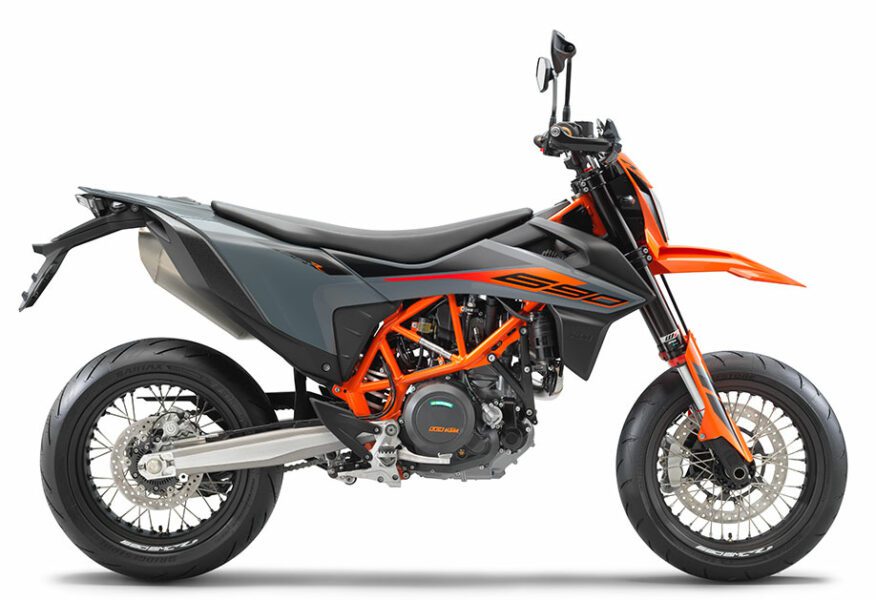
KTM 690 SMC
Are you confused by all these abbreviations? Let's briefly explain to everyone who is not so close to the family of single-cylinder "oranges".
The SM (Supermoto) 690, introduced last year, is the first of a collection that replaces the previous generation LC4 with the designation 640. This is an everyday bike that can be ridden very fast on the race track thanks to its sporty roots. and quality components. The R is an improved version on the same frame with better suspension and brakes, while the SMR series are purebred racing cars that cannot be registered for road use and are reserved exclusively for closed circuits. If you repeat the question - then for whom is this year's novelty SMC?
It traces its roots to its predecessors with the SC or "Super Competition" (enduro) surname, and later the SMC, which is a version of the SC on 17-inch wheels with wider crosses and more powerful brakes. It's a completely legal motorcycle with headlights, turn signals, a meter and all that junk, and at the same time the last step before racing cars.
Well, it's also possible to race – Gorazd Kosel proved this for several years in the Slovenian championship, finishing fourth in the strongest class with SMC. Having traveled with him to work for a week, he took off the headlights, pasted the starting numbers and drove.
The 690 SMC is based on the enduro model, which also appeared on and off-road this year. The frame is different from the SM and the biggest novelty is the support structure that supports the rear of the bike (seat, passenger's legs, muffler...). This part used to be made of aluminum, but now they have opted for plastic! More precisely, a plastic fuel tank is installed in this part, which took over the task of the carrier. Very innovative!
This leaves enough room above the unit for a large air filter chamber, which allows fresh air to flow through the electronic power supply into the combustion chamber of the new single-cylinder machine.
If you board the SMC directly from the SM, you will first notice the spartan working environment of the driver. The high seat is narrow and stiff, the pedals are pushed back and the bike is very thin between the legs. The clutch control with hydraulic oil is very soft and feels good, the transmission is short, precise and a little sporty.
The device is a delicacy of a special kind, as the power, given that it is a single-cylinder, is truly enormous. They managed to reduce vibrations, although there are more of them on the handlebars due to a different mount and frame compared to the Supermot. Unlike its predecessor 640, the power is distributed in a higher speed range, which means that the shaft response is 3.000 rpm worse, then the "machine" wakes up and at 5.000 on the speed indicator goes out.
To be honest, pull the steering wheel, shift your body weight back and at the same time turn on the gas in third gear at a speed of about 80 kilometers per hour, the front wheel will rise and fly into the plane. Not to mention how easily we can sit on the rear wheel in first gear, even when the bike is still in the corner.
The ease of driving and the straightness of the excellent suspension and brake components are strong arguments that such a toy simply cannot drive slowly, so you would be happy to try it out on the race track. Maybe even the state championship in the touring class.
At the moment, the production version does not have the best slot machine called supermoto. The only concern that came with riding at a playful pace on winding Austrian roads was endurance. Many people know that single-cylinder cars are not exactly lovers of high speeds. Well, the head of development said in a conversation that the new unit breaks down less than the "old" LC4, despite the more power and desire to spin. If that's true, then I don't see the need for two cylinders in the 750cc class. Anyone who wants more should buy the LC8.
Test car price: 8.640 EUR
engine: single-cylinder, four-stroke, liquid-cooled, 654 cc? , 4 valves per cylinder, Keihin electronic fuel injection.
Maximum power: 46 kW (3 "horsepower") at 63 rpm.
Maximum torque: 64 Nm @ 6.000 rpm
Energy transfer: 6-speed gearbox, hydraulic sliding clutch, chain.
Frame: chrome-molybdenum rod, fuel tank as an auxiliary support element.
Suspension: WP fi 48mm front adjustable inverted fork, 275mm travel, rear adjustable single damper, 265mm travel.
brakes: front disc fi 320 mm, radially mounted Brembo four-tooth jaws, rear disc fi 240, single-row jaws.
Tires: front 120 / 70-17, back 160 / 60-17.
Wheelbase: 1.480 mm.
Seat height from ground: 900 mm.
Fuel tank: 12 l.
Weight (without fuel): 139, 5 kg.
We praise and reproach
+ motor
+ conductivity
+ brakes
+ suspension
+ design
- Vibrations on the steering wheel
– do I really have to mention (not) comfort?
Matevž Hribar, photo: Alex Feigl
